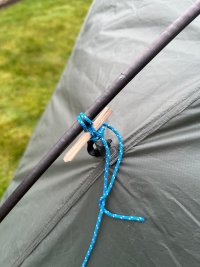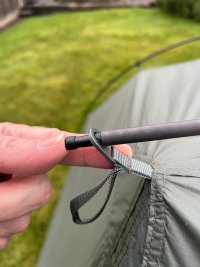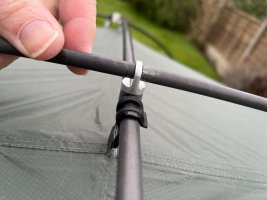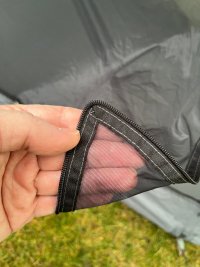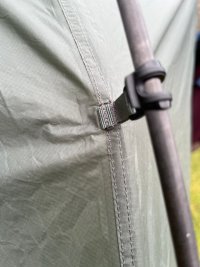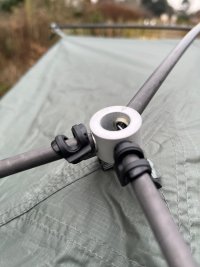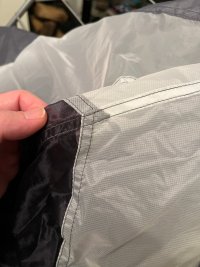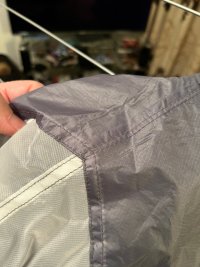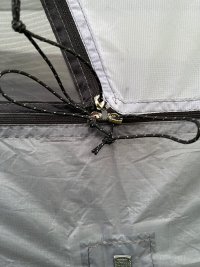Durston X-Dome 1+ Review
I’ll start by saying that I don’t usually chase down extreme lightweight gear; I’ve always taken the view that I’d be better shedding the extra 5 Kg body weight before shaving small amounts off my trekking kit. Having said that, I don’t carry much these days – lowland and in the canoe it’s usually a tarp, up in the mountains I still use my old Saunders Spacepacker. The tent is now getting a bit long in the tooth (probably 40 years old) but has served me well. I’ve had to carry out minor repairs lately so I’m actively looking for a replacement; the opportunity to check out the Durston X-Dome was too good to miss.
I’m not going to repeat a lot of what Hugh said in his excellent review earlier in the month but just add my own thoughts and observations. I really wanted to like this tent, and in many ways I do: it hits the right price point; it’s lightweight and compact; and it appears well made, but for now I'm not totally convinced. I must confess, I was running out of time, and I may think differently if I was to use the tent for a longer period (or had more practice pitching it).
First, weight: as has been said it is extremely lightweight coming in at around the 1Kg mark including the optional footprint. However, it is firmly a one-man tent. In comparison my Spacepacker is exactly twice that weight but comfortably takes two people and the weight can be distributed between each. Pack size the X-Dome is 52cm x 15cm but that can be compressed a little to nearer 11 or 12cm quite easily. Again, in comparison, the Spacepacker is exactly the same pack size but doesn’t compress much below the 15cm.
That low weight is reflected in the material; it doesn’t feel anything like as robust as I’m used to. The flysheet feels very thin and is quite noisy; it sounds almost like a crisp packet (more later). Having said all that, I don’t think the material is necessarily weaker, but I don’t think it will last 40 years of use either.
Pitching in the calm was straight forward. However, in a gale it would be quite tricky. I hadn’t seen Dan Durston’s excellent video (link below) before pitching, but I’d already worked out that I would have to peg it down firmly during pitching in anything but a light breeze. There’s a lot of lightweight floppy pole to deal with but, with practice, I think they could be joined up as you went along to keep them under control.
Having got the flysheet up, connected to the poles on the four corners, I went to install the footprint ground sheet. I unzipped the door and the front of the tent collapsed by 10cm as the tension across the front was lost. OK, I managed to adjust it to get the front back up but not all the way. Unfortunately, the footprint doesn’t cover the vestibule area (I would prefer that personally) so you can’t use it as an anchor for the pole feet. If you look closely at one point on the video when Dan undoes the door you can see the tent sag slightly, so it wasn’t just me.
Then the inner: in practice, if I was taking this tent out, I’d leave the inner connected to the fly when packed. The inner ground sheet clips to three of the corners of the fly but the last corner is kept taught by a long thin guy running on the floor to the vestibule pole foot – I didn’t like this much, and I think I would use a couple of small pegs. Apart from anything else, any gear you store or use in the vestibule will keep snagging the guy.
Inside has plenty of space in the head end (1.3m) and enough in the foot end (0.7m). A sleep mat up to 70cm will fit in easily. On top of that, and one of the tent’s most attractive features, the head-room is impressive with pretty near-vertical walls.
Outside I struggled to get a taught setup. I believe the tent would benefit from shaped side panels and head-end panel on the flysheet to enable them to be pegged out without ruckling the fabric. This could easily be done along the door zip for the front and would improve the vestibule pegging. I would also prefer elastic pegging out points instead of the very short cord guys. The head-end panel was particularly problematic; I couldn’t pitch it well enough to guarantee it wouldn’t touch the inner in a breeze. There’s no guy fitted to the bottom of this panel, just a loop (that may be a supply fault).
For windier weather there are good guying off loops on the four corner seams but no guys are supplied. I appreciate they would add to the cost and weight, but I think they should be included. On both sides there are pockets in the roof of the flysheet to allow a trekking pole to be inserted and this would provide improved stability in bad weather.
Even in the slight breeze there was noise from the fly rustling; as said before, it’s a very ‘crisp’ material. I’m sure I could improve the pitching a little, but I don’t think I’d get it taught enough to eliminate it.
In very windy weather I would be worried that the near vertical sides wouldn’t shed the wind as well as I’m used to and, although guys will help, I don’t think it would be possible to stop the sides being pushed in – again, shaped side panels would help this.
In conclusion, I quite like the design, it’s a sensible price, very light, and roomy for one person. I like the addition of the pockets for the trekking poles and other little details. It’s described as a four-season tent, but I probably wouldn’t use it in the mountains in winter – perhaps, using the added trekking poles and guys it would survive, but I’d be worried. I think the design (especially the shape of the panels) could be improved but, I assume, that would add cost.
So, I can’t justify ordering one, others with different priorities will think differently I’m sure.
Looks like I’ll be getting the repair kit out for another season

Dan's excellent video:
Durston X-Dome | Pitching Guide
